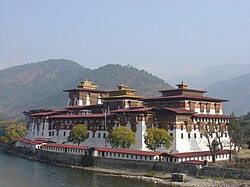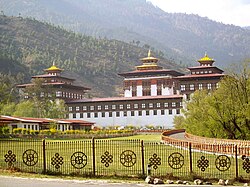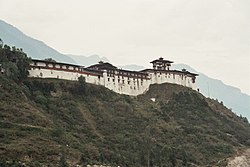Dzongpen
 |
|---|
Dzongpen(Dzongkha:རྗོང་དཔོན་;Wylie:rjong-dpon;also spelled "Dzongpon," "Dzongpön," "Jongpen," "Jongpon," "Jongpön" ) is aDzongkhaterm roughly translated as governor ordzonglord.Bhutanesedzongpens, prior to unification, controlled certain areas of the country, but now hold no administrative office. Rather, dzongpens are now entirely subservient to theHouse of Wangchuck.
Traditionally, Bhutan comprised nine provinces:Trongsa,Paro,Punakha,Wangdue Phodrang,Daga(also Taka, Tarka, or Taga),Bumthang,Thimphu,Kurtoed(also Kurtoi, Kuru-tod), andKurmaed(or Kurme, Kuru-mad).[1]The Provinces of Kurtoed and Kurmaed were combined into one local administration, leaving the traditional number of governors at eight. While some lords ruled fromdzongs(dzongpens), others held the title ofpenlop(Dzongkha:དཔོན་སློབ་;Wylie:dpon-slob;also "Ponlop" ), a title also translated as "governor," though penlops tended to be more powerful.
Dzongpens ruled inByagha,Dalay,Dalingkote,Ha,Kham,Punakha(the "Punab" ),Singhi,Tashichho Dzong,Thimphu(the "Thimphub" ),Tuwa,andWangdue Phodrang(the "Wangzob" ).[2]
Under thedual system of government,penlopsand dzongpens were theoretically masters of their own realms but servants of theDruk Desi.In practice, however, they were under minimal central government control, and thePenlop of Trongsaand Penlop of Paro dominated the rest of the local lords.[3]And while all governor posts were officially appointed byShabdrungNgawang Namgyal,later theDruk Desi,some offices such as thePenlop of Trongsawerede factohereditary and appointed within certain families. Penlops and dzongpens often held other government offices such asDruk Desi,governor of other provinces, or a second or third term in the same office.[4]
History[edit]
Under Bhutan's early theocraticdual system of government,decreasingly effective central government control resulted in thede factodisintegration of the office ofShabdrungafter the death of ShabdrungNgawang Namgyalin 1651. Under this system, the Shabdrung reigned over the temporalDruk Desiand religiousJe Khenpo.Two successor Shabdrungs – the son (1651) and stepbrother (1680) of Ngawang Namgyal – were effectively controlled by the Druk Desi and Je Khenpo until power was further splintered through the innovation of multiple Shabdrung incarnations, reflecting speech, mind, and body. Increasingly secular regional lords (penlopsand dzongpens) competed for power amid a backdrop of civil war over the Shabdrung and invasions fromTibet,and theMongol Empire.[5]The penlops ofTrongsaandParo,and the dzongpons ofPunakha,Thimphu,andWangdue Phodrangwere particularly notable figures in the competition for regional dominance.[5][6]

Within this political landscape, theWangchuck familyoriginated in theBumthang regionof central Bhutan.[7]The family belongs to the Nyö clan, and is descended fromPema Lingpa,a BhutaneseNyingmapasaint. The Nyö clan emerged as a local aristocracy, supplanting many older aristocratic families of Tibetan origin that sided with Tibet during invasions of Bhutan. In doing so, the clan came to occupy the hereditary position ofPenlop of Trongsa,as well as significant national and local government positions.[8]
ThePenlop of Trongsacontrolled central and Bhutan; the rival Penlop of Paro controlled western Bhutan; anddzongponscontrolled areas surrounding their respectivedzongs.Eastern dzongpens were generally under the control of the Penlop of Trongsa, who was officially endowed with the power to appoint them in 1853.[4]: 106, 251 The Penlop of Paro, unlike Trongsa, was an office appointed by theDruk Desi's central government. Because western regions controlled by the Penlop of Paro contained lucrative trade routes, it became the object of competition among aristocratic families.[8]
Punakha Dzongpens[edit]


Below are the Dzongpens ofPunakha,also called "Punab."
| Number | Name |
|---|---|
| 1 | PunabPekar Rubgye |
| 2 | PunabTenzin Drukda |
| 3 | PunabDruk Pelzang |
| 4 | PunabTenpa Wangchuck |
| 5 | PunabDalub Tobgye |
| 6 | PunabDang Tashi |
| 7 | PunabDamchho Rinchhen |
| 8 | PunabNgodub |
| 9 | PunabPhuntsho Dorji |
| 10 | PunabThonglay |
| 11 | PunabWangchuck |
| 12 | PunabWangsha |
Thimphu Dzongpens[edit]
Below are the Dzongpens ofThimphu,also called "Thimphub."


| Number | Name |
|---|---|
| 1 | ThimphubAwu Tshering |
| 2 | ThimphubNorbu |
| 3 | ThimphubNgwang Gyeltshen |
| 4 | ThimphubTashi Dorji |
| 5 | ThimphubDruk Rubgye |
| 6 | ThimphubSonam Drugyel |
| 7 | ThimphubDondub |
| 8 | ThimphubDruk Phuntsho |
| 9 | ThimphubDruk Tenzin |
| 10 | ThimphubChhoki Gyeltshen (Tshewang Rinchhen)[4]: 135, 251 [Thimphub 1] |
| 11 | ThimphubUma Dewa (Sherub Tharchhin)[4]: 252 [Thimphub 2] |
| 12 | ThimphubKasha |
| 13 | ThimphubKarma Drugyel |
| 14 | ThimphubKhasab Tobgye |
| 15 | ThimphubKawang Manghkhel |
| 16 | ThimphubLama Thewang |
| 17 | ThimphubAlu Dorji |
| 18 | ThimphubKunzang Thinley |
| 19 | ThimphubPema |
| 20 | ThimphubKunzang Thinley[Thimphub 3] |
| Notes: | |
Wangdue Dzongpens[edit]


Below are the Dzongpens ofWangdue Phodrang,also called "Wangzob."[2]: 132, 141 [4]: 86
| Number | Name |
|---|---|
| 1 | WangzobChhoje Namkha Rinchhen |
| 2 | WangzobGedun Chhophel |
| 3 | WangzobNgwang Tshering |
| 4 | WangzobDruk Tenzin |
| 5 | WangzobSangye Tenzin |
| 6 | WangzobLepi Sherub |
| 7 | WangzobSonam Lhundup |
| 8 | WangzobSangay |
| 9 | WangzobKunga Gyeltshen |
| 10 | WangzobPhuntsho Namgyel |
| 11 | WangzobDalub Tobgye |
| 12 | WangzobSigay |
| 13 | WangzobTenzin Namgyel |
| 14 | WangzobKawang Sangay |
| 15 | WangzobAngdu |
| 16 | WangzobJigme Namgyel[Wangzob 1] |
| 17 | WangzobThinley Tobgye |
| 18 | WangzobAshang Jampa |
| 19 | WangzobKodu |
| 20 | WangzobDomchu |
Notes:
| |
See also[edit]
References[edit]
- ^Madan, P. L. (2004).Tibet, Saga of Indian Explorers (1864–1894).Manohar Publishers & Distributors. p. 77.ISBN978-81-7304-567-7.Retrieved2011-08-14.
- ^ab
 This article incorporates text from this source, which is in thepublic domain:White, J. Claude (1909). "Appendix I – The Laws of Bhutan".Sikhim & Bhutan: Twenty-One Years on the North-East Frontier, 1887–1908.New York: Longmans, Green & Co. pp. 11, 272–3, 301–10.ISBN9780598739278.Retrieved2010-12-25.
This article incorporates text from this source, which is in thepublic domain:White, J. Claude (1909). "Appendix I – The Laws of Bhutan".Sikhim & Bhutan: Twenty-One Years on the North-East Frontier, 1887–1908.New York: Longmans, Green & Co. pp. 11, 272–3, 301–10.ISBN9780598739278.Retrieved2010-12-25.
- ^Zetland (Marquis of), Lawrence John Lumley Dundas; Ronaldsha, E.; Asian Educational Services (2000).Lands of the thunderbolt: Sikhim, Chumbi & Bhutan.Asian Educational Services. p. 204.ISBN978-81-206-1504-5.Retrieved2011-08-10.
- ^abcdefgDorji, C. T. (1994)."Appendix III".History of Bhutan based on Buddhism.Sangay Xam, Prominent Publishers. p. 200.ISBN978-81-86239-01-8.Retrieved2011-08-12.
- ^ab
 One or more of the preceding sentences incorporates text from this source, which is in thepublic domain.Worden, Robert L. (September 1991). Savada, Andrea Matles (ed.).Bhutan: A Country Study.Federal Research Division.Administrative Integration and Conflict with Tibet, 1651–1728.
One or more of the preceding sentences incorporates text from this source, which is in thepublic domain.Worden, Robert L. (September 1991). Savada, Andrea Matles (ed.).Bhutan: A Country Study.Federal Research Division.Administrative Integration and Conflict with Tibet, 1651–1728.
- ^
 One or more of the preceding sentences incorporates text from this source, which is in thepublic domain.Worden, Robert L. (September 1991). Savada, Andrea Matles (ed.).Bhutan: A Country Study.Federal Research Division.Civil Conflict, 1728–72.
One or more of the preceding sentences incorporates text from this source, which is in thepublic domain.Worden, Robert L. (September 1991). Savada, Andrea Matles (ed.).Bhutan: A Country Study.Federal Research Division.Civil Conflict, 1728–72.
- ^Crossette, Barbara (2011).So Close to Heaven: The Vanishing Buddhist Kingdoms of the Himalayas.Vintage Departures.Random HouseDigital, Inc.ISBN978-0-307-80190-6.Retrieved2011-08-10.
- ^abGter-ston, Padma-gliṅ-pa; Harding, Sarah (2003). Harding, Sarah (ed.).The life and Revelations of Pema Lingpa.Snow Lion Publications. p. 24.ISBN978-1-55939-194-8.Retrieved2011-08-10.
- ^Dorji, C. T. (1995).A political & religious history of Bhutan, 1651-1906.Delhi,India:Sangay Xam; Prominent Publishers.Retrieved2011-08-15.
